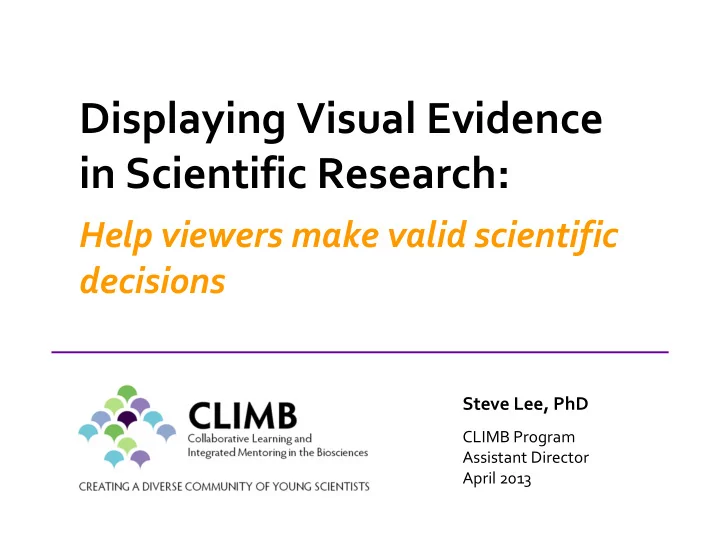

Displaying Visual Evidence in Scientific Research: Help viewers make valid scientific decisions Steve Lee, PhD CLIMB Program Assistant Director April 2013
Our CLIMB curriculum of workshops on communication in scientific research 1) Delivering scientific presentations and posters for impact: Make it stick with SUCCESs 2) Crafting the introduction to a scientific presentation: Create a mystery box 3) Communicating and collaborating across disciplines: Use simple words 4) Displaying visual evidence in scientific presentations: Help viewers make valid scientific decisions 2
Let’s consider 2 case studies from Tufte’s Visual Explanations Effective displays help lead to valid arguments and true conclusions. Ineffective displays often lead to invalid arguments and false conclusions. Garbage In - Garbage Out 3
Case 1: Dr John Snow intervenes in a cholera epidemic ● Cholera breaks out in London in 1854 Context ● Cholera: rapid dehydration (diarrhea, vomiting) and death ● fatality rate: 50% ● killed millions in other epidemics ● Deficiencies in: Problems ○ understanding of bacteria ○ technology ○ sanitary living conditions ● How is cholera transmitted? Questions ● How can we stop this cholera epidemic? (1) breathing vapors of decaying matter Hypotheses (2) drinking contaminated water Cholera is spread by: 4
Dr John Snow investigated the cholera epidemic • Consider Are locations of water sources and deaths significant? • He obtained death certificates and created a visual map. the data (see handout) • He reported his findings to the local authorities Communicate • He had to convince them that a specific water source and convince was contaminated, and caused cholera • Handle on the Broad Street water pump was removed Conclusions • Epidemic soon ended Snow’s visual evidence helped to make valid scientific decisions. 5
Is your visual display helping or hindering valid scientific decisions? Mark Monmonier’s How to Lie Gregory Joseph’s Modern Visual Evidence quarterly data with Maps aggregates of Snow’s map: fiscal years calendar years 6
Decision to Launch the Space Shuttle Challenger Case 2: in January 1986 ● O-rings seal segments of the booster rockets. Context ● Previous launches showed damage to the O-rings. ● All past launches occurred at temperatures of >53 ° F. Problems ● Forecasted temperature of the launch was 26-29 ° F. ● Will the O-rings maintain their seal at 26-29 ° F? Questions ● Should the launch proceed? ● Engineers: No, and then Yes Hypotheses ● NASA officials: Yes 7
Engineers at Morton Thiokol Inc (MTI) initially argued against the launch ● MTI faxed 13 slides to NASA ● Slide 1 of 13 Blow-by = soot and gases blowing by O-ring seals SRM = solid rocket motor What’s missing here? 8
Engineers at Morton Thiokol Inc (MTI) initially argued against the launch ● Slide 2 of 13 What’s missing here? 9
MTI initially argued against the launch ● MTI faxed 13 slides to NASA ● How would you respond to this argument? Was this effective? ● This was MTI’s only no-launch recommendation in 12 years. ● A NASA official responded that he was “appalled” by MTI’s recommendation not to launch, and asked them to reconsider. 10
NASA officials asked MTI to reconsider, and MTI reversed their decision After 1 minute from launch, the space shuttle Challenger exploded and 7 astronauts died. 11
Post-Analysis: MTI’s original conclusion was true, but with an ineffective argument. ● Commission investigating the accident: “A careful analysis of the flight history of O-ring performance would have revealed the correlation of O-ring damage and low temperature. Neither NASA nor Thiokol carried out such an analysis; consequently, they were unprepared to properly evaluate the risks of launching the 51-L [Challenger] mission in conditions more extreme than they had encountered before.” ● How might the data have been better analyzed, presented and communicated? 12
Let’s evaluate MTI’s 2 nd attempt in visual displays after the accident ● See the handout ● What are the pro’s and con’s of this data display? ● What can be done to help viewers make a valid scientific decision? 13
Tufte’s revision summarizes all data into a graph with a “Damage Index” Tufte’s visual display would have helped viewers make a valid scientific decision. 14
Take-Home Lessons from Two Case Studies ● Case 1: John Snow intervened in a cholera epidemic ○ He summarized all relevant info in a simple map ○ He helped viewers make a valid scientific decision ● Case 2: Decision to launch the space shuttle ○ MTI had all info, but created an ineffective data display, even after the accident ○ Tufte’s revision summarized all relevant info in a simple graph ○ Tufte helped viewers make a valid scientific decision 15
Recommend
More recommend